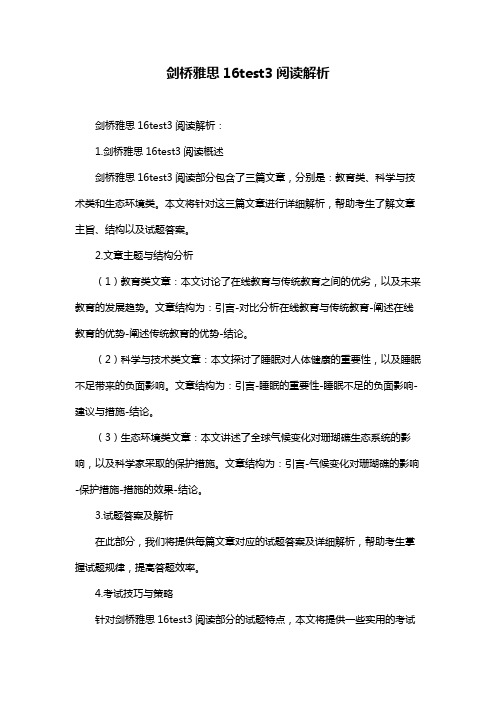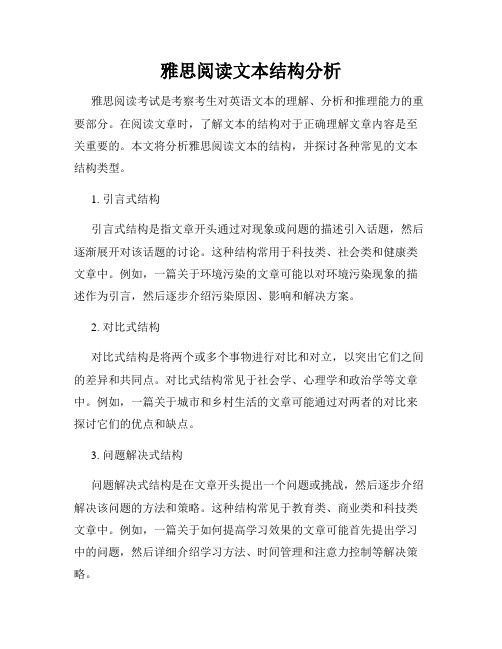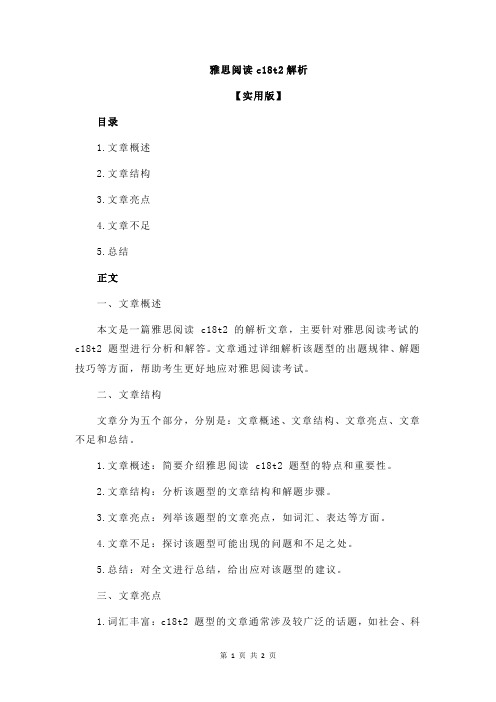雅思阅读文章结构特点分析
雅思阅读文章逻辑结构与思路分析

雅思阅读文章逻辑结构与思路分析在雅思阅读考试中,理解文章的逻辑结构以及有效分析思路是取得高分的重要因素之一。
本文将介绍雅思阅读文章的常见逻辑结构和思路分析方法,帮助考生更好地应对考试。
一、逻辑结构1. 原因-结果结构:文章首先描述某个现象或问题,然后分析其产生的原因以及导致的结果。
该结构常见于科技、环境、社会等方面的文章。
2. 问题解决结构:文章提出一个问题或挑战,接着介绍解决问题的方法或策略,并对其进行分析和评价。
这种结构常见于教育、管理、政治等领域的文章。
3. 对比-对比结构:文章先介绍两个或多个相似或不同的事物,然后对它们进行比较和对比。
该结构常见于历史、文化、科学等领域的文章。
4. 分类-定义结构:文章先对某一概念或主题进行分类,然后对每个分类进行详细定义和描述。
这种结构在科学、医学、法律等领域的文章中较为常见。
5. 时间顺序结构:文章根据事物的发展过程或事件的发生顺序,按时间先后进行叙述。
此结构多见于历史、传记、报道等类型的文章。
6. 问题-解答结构:文章首先阐述一个问题,然后通过提出解决方案或方法来回答问题。
这种结构常见于科技、哲学、健康等方面的文章。
二、思路分析1. 关键词分析:仔细阅读题目和文章,并挖掘出关键词。
这些关键词通常会出现在题目、段落开头或者重要观点的陈述中。
通过关键词分析,可以更好地理解文章的主题和重点。
2. 预测问题:在阅读文章之前,尽量预测可能会涉及到的问题。
这有助于聚焦注意力,提前准备思维框架,并在阅读过程中更有目的性地寻找答案。
3. 主旨句捕捉:主旨句通常出现在段落的开头或结尾,是段落的核心句子。
通过抓住主旨句,可以迅速了解段落的主题和作者的观点。
同时,主旨句也有助于整合文章的信息,形成整体的了解。
4. 上下文推测:阅读时,注意抓住与问题相关的上下文信息。
有时候,答案并没有明确提及,而是通过推理和推测得出的。
通过理解和分析文章的上下文,可以更好地推断答案。
5. 反义词辨析:文章中可能会出现一些反义词或者相对词,比如"but"、"however"等。
剑桥雅思16test3阅读解析

剑桥雅思16test3阅读解析剑桥雅思16test3阅读解析:1.剑桥雅思16test3阅读概述剑桥雅思16test3阅读部分包含了三篇文章,分别是:教育类、科学与技术类和生态环境类。
本文将针对这三篇文章进行详细解析,帮助考生了解文章主旨、结构以及试题答案。
2.文章主题与结构分析(1)教育类文章:本文讨论了在线教育与传统教育之间的优劣,以及未来教育的发展趋势。
文章结构为:引言-对比分析在线教育与传统教育-阐述在线教育的优势-阐述传统教育的优势-结论。
(2)科学与技术类文章:本文探讨了睡眠对人体健康的重要性,以及睡眠不足带来的负面影响。
文章结构为:引言-睡眠的重要性-睡眠不足的负面影响-建议与措施-结论。
(3)生态环境类文章:本文讲述了全球气候变化对珊瑚礁生态系统的影响,以及科学家采取的保护措施。
文章结构为:引言-气候变化对珊瑚礁的影响-保护措施-措施的效果-结论。
3.试题答案及解析在此部分,我们将提供每篇文章对应的试题答案及详细解析,帮助考生掌握试题规律,提高答题效率。
4.考试技巧与策略针对剑桥雅思16test3阅读部分的试题特点,本文将提供一些实用的考试技巧与策略,包括:(1)提高阅读速度:通过训练提高阅读速度,以便在规定时间内完成试题。
(2)抓住文章主旨:在阅读过程中,关注文章的主题句、段落首尾句,迅速把握文章大意。
(3)利用题干关键词:在解答问题时,利用题干中的关键词在文章中定位答案。
(4)识别题型:熟悉各类题型,掌握解题思路和方法。
5.实战演练与建议根据剑桥雅思16test3阅读部分的试题特点,建议考生在备考过程中进行大量实战演练,提高自己的应试能力。
同时,针对性地总结自己的弱点,加强对各类题型的掌握。
总之,剑桥雅思16test3阅读部分的文章解析为考生提供了很好的学习材料。
通过本文的解析,考生可以更好地理解文章结构、掌握试题答案,并提高自己的阅读技巧。
雅思阅读文本结构分析

雅思阅读文本结构分析雅思阅读考试是考察考生对英语文本的理解、分析和推理能力的重要部分。
在阅读文章时,了解文本的结构对于正确理解文章内容是至关重要的。
本文将分析雅思阅读文本的结构,并探讨各种常见的文本结构类型。
1. 引言式结构引言式结构是指文章开头通过对现象或问题的描述引入话题,然后逐渐展开对该话题的讨论。
这种结构常用于科技类、社会类和健康类文章中。
例如,一篇关于环境污染的文章可能以对环境污染现象的描述作为引言,然后逐步介绍污染原因、影响和解决方案。
2. 对比式结构对比式结构是将两个或多个事物进行对比和对立,以突出它们之间的差异和共同点。
对比式结构常见于社会学、心理学和政治学等文章中。
例如,一篇关于城市和乡村生活的文章可能通过对两者的对比来探讨它们的优点和缺点。
3. 问题解决式结构问题解决式结构是在文章开头提出一个问题或挑战,然后逐步介绍解决该问题的方法和策略。
这种结构常见于教育类、商业类和科技类文章中。
例如,一篇关于如何提高学习效果的文章可能首先提出学习中的问题,然后详细介绍学习方法、时间管理和注意力控制等解决策略。
4. 原因和结果式结构原因和结果式结构是通过分析某种现象的原因和导致的结果来展开文章。
这种结构常见于自然科学、医学和社会科学的文章中。
例如,一篇关于烟草对健康的影响的文章可能开始解释吸烟的原因,然后介绍吸烟对健康的不良影响。
5. 比较式结构比较式结构是从两个或多个对象或概念之间的相似之处和差异之处入手,展开文章内容。
这种结构常见于文学评论、艺术评论和历史类文章中。
例如,一篇关于两位作家的写作风格的文章可以通过比较句子结构、词汇选择和句子长度等方面来探讨它们的相同点和不同点。
综上所述,雅思阅读文章的结构多种多样,不同的文章类型会采用不同的结构方式。
了解文本结构有助于读者更好地理解文章内容,提高阅读效果。
在备考雅思阅读时,考生应该通过阅读各种文章来熟悉不同的结构类型,并学会运用不同的阅读策略来应对不同的结构特点,从而更好地应对考试挑战。
雅思阅读c18t2解析

雅思阅读c18t2解析
【实用版】
目录
1.文章概述
2.文章结构
3.文章亮点
4.文章不足
5.总结
正文
一、文章概述
本文是一篇雅思阅读 c18t2 的解析文章,主要针对雅思阅读考试的c18t2 题型进行分析和解答。
文章通过详细解析该题型的出题规律、解题技巧等方面,帮助考生更好地应对雅思阅读考试。
二、文章结构
文章分为五个部分,分别是:文章概述、文章结构、文章亮点、文章不足和总结。
1.文章概述:简要介绍雅思阅读 c18t2 题型的特点和重要性。
2.文章结构:分析该题型的文章结构和解题步骤。
3.文章亮点:列举该题型的文章亮点,如词汇、表达等方面。
4.文章不足:探讨该题型可能出现的问题和不足之处。
5.总结:对全文进行总结,给出应对该题型的建议。
三、文章亮点
1.词汇丰富:c18t2 题型的文章通常涉及较广泛的话题,如社会、科
技、文化等,因此文章中的词汇也相对丰富。
考生在解答这类题目时,可以学到很多有用的词汇和表达。
2.解题技巧:文章中提供了一些解题技巧,如快速浏览、寻找关键词等,这些技巧对于提高解题速度和准确率具有很大的帮助。
四、文章不足
1.文章长度:由于 c18t2 题型的文章较长,考生在解答过程中可能会感到时间紧迫,需要提高阅读速度。
2.题目难度:随着题型的难度逐渐加大,考生在解答时可能会遇到较大的挑战,需要具备较强的逻辑思维能力。
五、总结
总的来说,雅思阅读 c18t2 题型是一项重要的考试内容,考生需要对其有充分的了解和准备。
2023年雅思阅读真题的6种段落结构整理

2023年雅思阅读真题的6种段落结构整理雅思阅读真题的6种段落结构明白雅思阅读文章的段落结构对于雅思阅读题目的解答关心特别大,由于大家知道了文章结构就可以到相应的部分去查找阅读题目的答案,特别省时省力.下面我就与大家共享雅思阅读文章的6种段落结构,供大家参考.雅思阅读真题的6种段落结构一般的段落结构可概括为六种:一.总分段落.一般其次句话有for example/for instance之类举例关系词时, 那么可以断定第一句为中心句.如剑3T2section C段落可说明此问题.这种文章结构在雅思阅读文章中是最常见的一种.二.总分总段落.这种段落就是在总分结构段落最终加一个总结句.如剑3T1P3就是这种段落,通过分析此段中心句仍是第一句.这种文章结构和上面的结构一样,在雅思阅读文章中也是最常见的一种.三.分总段落.这种段落把主题句放在了最终.如《剑桥高校老样题》P2Q12中心句为最终一句This is a purely person-skills match approach to selection.这是个下定义句型,一般下定义的句型(A is B, A is defined as.,A is called, The definition of A is .)我们可以看之为中心句,这种方法在剑2T1P2B段和E段都有体现.这种段落结构而后上面的两种不一样,这种结构的消失并不多.四.分总分段落.即在分总的基础上连续分述某些详细内容,参见剑3T1P3Q3.五.对比段落结构.此种段落的特征为段落中间方向发生转变(如转折),因此,假如段落当中消失but, however, while之类转折词,转折后面是重点,可作为中心句的位置.如剑6T2P1B段.这种段落结构在雅思阅读文章结构中是以说明性的科技文章比较多.六.并列段落结构.几个共同的例子说明同样的问题.如剑2T3P3A 段.以上6雅思文章的段落结构都是一些特别常见的段落结构形式,但是大家想要把握这些结构还是需要经过多次的雅思阅读文章的练习才能达到的.雅思阅读:高效提分必需把握的三大技巧雅思阅读单词要求多少? 7000-8000!什么?我四级都没过,2000都觉得多,坑爹了这是!小盆友们不要急,的确,阅读是四门课中对单词量要求最高的科目,但是要求的质是最低的,只要能明白个也许即可。
雅思阅读文章结构特点分析

在雅思阅读考试中,很多考生都反映文章的难度太高,几乎读不懂。
如果对文章的内容不理解,在做题的过程中就很难保证正确率。
其实理解文章内容的第一步是要先理清文章的结构,这样才能够从整体上把握思路,读懂文章的内容。
下面为大家具体分析雅思阅读的文章结构特点,希望对大家有帮助。
雅思阅读文章的学术性往往很强,但另一方面也决定了相对固定的文章结构。
因为学术是严谨的,在形式上它有一套严格的规范。
我们只要掌握了这套规范,就可以很轻松的掌握文章的结构规律。
雅思阅读文章可以分为三大类:介绍性的学术说明文、论辩性的学术论文以及环境自然现象类文章。
说明文只是对一个既定的事实进行客观介绍和陈述,不包含argument,教科书就属于这一类;而学术论文通常针对一个悬而未决的问题,进行论证,继而提出解决方案,其过程就是提出问题、分析问题、解决问题;环境自然现象类文章主要是对一类自然环境现象的描述和解释。
下面我们就具体看一下这三类文章的结构特点。
一、介绍类学术说明文的结构要判断文章类别,一般看标题就可以。
介绍类文章是对某事物或现象进行描述或介绍,所以标题一般为名词短语或者以How开头的疑问句。
具体结构如下:-Introduce a phenomenon or a fact.-Detailed Description:Timeline/Different Aspects/Logic Development-Look into the future/Summary无论什么文章,起始段总是引出主题,所以多用叙述描写性语言,或介绍现象,或陈述事实,或交代问题。
在介绍类说明文中,中间断落是对事物细节的展开描述,各种话题可以通过三种不同方式展开。
第一类时间顺序,通常用于陈述一个历史事件,例如剑五中的“Johnson’s Dictionary”就是这一类。
第二类并列或递进,从各个侧面来介绍,例如剑四中的“What Do Whales feel?”,一看标题就知道是介绍鲸鱼各个感官的,属于并列结构。
(完整版)常见的三种雅思阅读文章结构类型

常见的三种雅思阅读文章结构类型雅思阅读文章题材五花八门,内容生硬又专业,要看懂都不容易,如何能在短短的2-3分钟内梳理出文章的架构和作者的写作思路呢?事实上,正是因为雅思文章的学术性和专业性,其文章结构和形式相对比较固定,于是我们就可以利用这一点来迅速掌握文章的结构了。
在此,小编将给考生们介绍常见的三种雅思阅读文章结构类型。
一、介绍说明类的文章(青岛雅思)这一类文章通常是对某个事物或现象进行的客观描述或介绍,一般考生可以通过其标题来进行判断。
具体的结构如下:1. Introduce an object or a fact2. Detailed descriptions3. Significance无论什么文章,首段通常都是引出主题,用客观描述性的语言来介绍,或者从背景部分切入,之后便是对该事物的具体展开描述了:事情的发展顺序,某个东西的具体特征介绍等等;最后结尾部分通常对该事物所带来了意义进行说明。
如剑桥5T1P1 Johnson’s Dictionary 在前三段交代完约翰逊字典出现的背景后,中间部分侧重交代字典的准备过程和具体的特征介绍,最后的部分描述了该字典给那个时代的社会,国家以及Johnson本人带来的重大意义。
二、问题解决类的文章关于问题解决类的文章,在雅思阅读中出现的频率很高,而且具体的结构相对更加固定,其结构如下:1. Introduce a phenomenon or a problem2. Causes3. Effects4. Measures or future(青岛雅思培训)这一类的文章倾向的是介绍一些消极负面的环境自然类问题,警惕世人引起大家的关注,因此它的几个构成要素也跟明确。
同样先引出主题,之后对该现象进行原因分析,影响分析(通常是负面的影响),鉴于严重的消极影响该采取的相应措施被提出,但如果有的问题暂时没有对策,还有待解决,作者就寄希望于未来。
考生如果对这种结构悉数于心,当碰到剑桥5T4P1的list of headings就能迅速又准确得解答出来。
雅思阅读文章语法与结构探索

雅思阅读文章语法与结构探索在雅思考试中,阅读是一个重要的部分。
为了帮助考生更好地应对阅读测试,本文将探讨雅思阅读文章的语法与结构。
一、引言雅思阅读测试要求考生理解并解析各种不同类型的文章,所以对于文章的语法和结构的理解非常重要。
本文将从句子结构、主谓一致、时态和语态等方面进行探讨。
二、句子结构在雅思阅读文章中,句子结构多种多样,有简单句、复合句和复杂句等。
了解不同类型的句子结构有助于更好地理解文章。
1. 简单句简单句是由一个主语和一个谓语组成的句子。
这种句子结构常用于叙述事实或表达简单的观点。
例句:The sun rises in the east.(太阳从东方升起。
)2. 复合句复合句由一个主句和一个或多个从句组成。
从句可以是名词性从句、形容词性从句或副词性从句。
例句:I will study hard so that I can pass the exam.(我会努力学习,以便能够通过考试。
)3. 复杂句复杂句由一个独立主句和一个或多个从属从句组成。
从属从句可以是名词性从句、形容词性从句或副词性从句。
例句:Although it was raining, they still went hiking.(尽管下着雨,他们还是去徒步旅行了。
)三、主谓一致主谓一致是句子中主语和谓语在人称和数上保持一致,是英语语法中的基本原则。
1. 单数主语+单数谓语例句:The cat is sleeping.(猫正在睡觉。
)2. 复数主语+复数谓语例句:The cats are sleeping.(猫们正在睡觉。
)3. 单数主语+复数谓语例句:The book and the pen are on the desk.(书和笔在桌子上。
)四、时态时态在文章中起到了非常重要的作用,它可以表达过去、现在和将来的动作或状态。
1. 一般现在时一般现在时用于表达客观事实、经常性动作和现时的状态。
例句:Water boils at 100 degrees Celsius.(水在100摄氏度时沸腾。
雅思阅读结构分析

雅思阅读三种文章结构分析为什么要读文章的结构呢?首先,这是雅思阅读的题型要求。
在雅思官方给出的阅读14种题型中,有一种难度较大的题型: 段落信息配对题(Which paragraph contains the following information?)它需要考生读完所有的命题信息点后,去全文搜索命题所对应的段落。
这对考生的阅读速度和搜索能力有着极高的要求。
通常多数考生全篇撒网,漫无目的地找信息,结果不是“快而不准”就是严重超时。
但是,若考生能提前洞悉文章的结构,就能了解命题信息点对应的文章大致范围,如文章靠前的段落还是靠后的段落?比如,剑桥5 test 3 passage 3中,有一道段落信息配对题,命题是:how AI might have a military impact. 根据该文章的标题:The Return o f Artificial Intelligence可知,关于命题中AI在军事上的影响应该放在靠后的段落进行说明,那么考生的选择范围至少缩小的一半。
若考生没有针对性的全篇覆盖,即使做出题,也是严重超时。
其次,应对定位难度大的题。
不能否认的是很多情况下做题不用浏览文章,在备考初期,找命题中的定位词去文中定位,这是烤鸭们必经的首要阶段。
但慢慢地,考生明显会感觉到定位难度的加大,如命题中的定位词被同义替换,定位时偶尔出现的乱序情况等等。
但试想,若考生在做题前就分析过文章结构,大概能抓住文章的每段的主旨,那么我们就不再是依赖某一两个词来定位,而是用语义来定位,即使出现乱序或者同义替换,我们也能轻松搞定。
最后,文章对应的考题一网打尽,提高速度。
考生通常习惯了先读命题再去文章中找需要的相关信息进行解题,殊不知,这是一种比较冒险的做法,因为当定位简单时这种方法的确最直接有效,但不能排除的是有的题定位难度很大,这时就只有文章结构阅读法才能很好的克服这个问题。
因此为了能将所有题一网打尽,考生应该在做题前快速地分析文章的结构和每段的主旨。
雅思雅思阅读文章的段落结构特点

雅思阅读文章的段落结构特点朗阁海外考试研究中心在雅思阅读考试的题型中有一种heading题,即题目配对题。
该题型的难度位居雅思各大题型之首,因为该题型要紧考查考生们对段落大致内容的把握能力,尽管很多考生认真读懂全段的每一句话乃至每一个单词,却仍然丈二僧人摸不着头脑。
事实上,这种在雅思题型中夺得难度头魁的题型并无考生们所想象的那么恐怖,应付这种题型,朗阁海外考试研究中心建议考生们第一要做的确实是“知己知彼,百战百胜”,也确实是说考生们第一要了解雅思阅读文章的段落结构特点。
由于西方人是直线式思维的,不同于中国人的螺旋式思维模式,因此雅思阅读文章的段落结构有其明显的特点,考生只要抓住这些特点就能轻松得出段落大意。
而雅思阅读文章的段落结构通常能够分为四种。
☆ 第一种:总分式结构如剑8 Test 4 Passage 1 Section DLessons all follow the same pattern.At the beginning, the pupils put solutions to the homework on the board, then the teachers comment, correct or elaborate as necessary. Pupils mark their own homework: this is an important principle in Japanese schooling as it enables pupils to see where and why they made a mistake, so that these can be avoided in future. No one minds mistakes or ignorance as long as you are prepared to learn from them.After the homework has been discussed, the teacher explains the topic of the lesson, slowly and with a lot of repetition and elaboration. Examples are demonstrated on the board; questions from the textbook are worked through first with the class, andthen…Only rarely are supplementary worksheets distributed in a maths class. The impression is that the logical nature of the textbooks and …renders work sheets unnecessary. At this point, the teacher would circulate and make sure that all the pupils were copying well.分析:此段属于明显的总分式结构,第一句“Lessons all follow the same pattern”统领整个段落,然后别离用“At the beginning”和“After the homework has been discussed”为信号,讲解整个课堂的讲课流程。
雅思阅读文章段落结构与关系

雅思阅读文章段落结构与关系雅思阅读部分是考试中的重要组成部分之一,要求考生在短时间内高效阅读并理解一篇文章。
为了顺利完成雅思阅读,了解文章段落结构与关系是非常重要的。
本文将介绍雅思阅读文章段落结构与关系的要点。
一、什么是文章段落结构在雅思阅读中,一篇文章通常由多个段落组成。
每个段落包含一定的信息,如一个观点、一个主题等。
文章段落结构是指这些段落互相连接、呼应的方式。
了解文章段落结构有助于我们更好地理解文章内容。
二、段落之间的关系1. 主题转换文章中的段落往往会从一个主题转换到另一个主题。
通过主题转换,作者可以引出新的观点、论证或提供相关的实例。
在段落之间进行主题转换时,我们需要注意关键词或词组的使用。
比如,第一段的主题是全球气候变化的影响,第二段的主题是政府应对气候变化的政策措施,可以在第二段的开头使用“另一方面”、“此外”等词来引入新的主题。
2. 因果关系段落之间还可以通过因果关系进行连接。
作者可能会在前一段提出某个原因,然后在下一段解释这个原因的结果。
在段落之间的因果关系中,使用诸如“因此”、“导致”、“由于”等词汇可以帮助读者理解作者的思路。
3. 递进关系递进关系是指文章段落中观点或论述的逐步发展。
作者可能会在一个段落中提出一个观点,然后在下一个段落中进一步展开或加强这个观点。
使用递进关系可以让文章的逻辑关系更加明确。
例如,第一段讨论了环境保护的必要性,第二段则进一步介绍了环境保护的重要举措。
三、段落结构的作用了解文章段落结构的作用有助于我们更好地理解和把握文章的主旨、论点和结论。
通过分析段落结构,我们可以更准确地找到关键信息,提高阅读效率。
1. 找到主题句每个段落通常都有一个主题句,它概括了整个段落的主题或主要观点。
找到主题句有助于我们快速抓住段落的关键信息。
主题句通常出现在段落的开头或结尾。
2. 理清段落关系分析段落结构有助于理清段落之间的逻辑关系。
通过梳理段落之间的关系,我们可以更好地理解文章的整体思路和论证过程。
- 1、下载文档前请自行甄别文档内容的完整性,平台不提供额外的编辑、内容补充、找答案等附加服务。
- 2、"仅部分预览"的文档,不可在线预览部分如存在完整性等问题,可反馈申请退款(可完整预览的文档不适用该条件!)。
- 3、如文档侵犯您的权益,请联系客服反馈,我们会尽快为您处理(人工客服工作时间:9:00-18:30)。
大多数雅思真题文章的结构是人们常说的“到金字塔”形式。
这是指在一篇文章中,最重
要的信息都放在开头部分,尤其是开头的前三段。
也就是说,一篇文章的主题(主题句)都出
现在前三段。
一般我们把这样的段落称为导语段。
文章一般把新闻所涉及的人物、时间、地点、过程和结果都交待出来。
读者读完了导语段,也就知道了新闻的关键信息。
接下来就是逐步向读者交待事件发生的起因、过程、影响等信息。
这是文章的主要部分,但是各种信息并不是平铺直叙的,而是按照它们的重要性先后出现的。
与事件直接相关的信
息被认为是最重要的,因此位置靠前,然后才是次要的信息。
文章的结构有时显得松散,段落之间的逻辑关系不紧密,这是因为需要交待的信息没有
一定的关联模式,只是发生的一些实事的铺陈。
新闻一般不要求结尾,尤其是总结性的结尾段。
在交待完事件的全过程后,作者通常加
上一两段与该消息有点关系、但是不是很重要的信息,作为新闻的结尾。
Student Face Bleak Job Market in Japan
(introduction &main idea)
TOKYO—More than 12,000 college students in Japan, who graduate next spring,packed into
the giant Tokyo Dome sports stadium Monday with the anxious hope oflanding jobs.
(more facts)
Hundreds lined up before dawn, some having traveled from distant cities fora huge job-counseling program organized by the ministry of Labor.
(background)
September brings the formal start of Japan's annual job-recruitment season.But after nearly five years of rece ssion and “job shock”, those entering thework force face the most forbidding season in years, and many have settled forjobs they would have once dismissed.
(quotes)
“I am looking for a job as receptionist, a sales clerk—it doesn't matter,”said Takako N akahara, who flew more than 500 miles from her two years college insouthern Japan for Monday's program.
(more detail)
High school and college graduates—especially women—have borne the brunt ofJapan's economic pain. Thanks in large part to the lifetime employment practicesof most Japanese companies, the nation's official unemployment rate is only 3.2percent—a level Americans would consider a victory over joblessness.。
